….. eat, drink, stroll. Stop and stare. Imagine and be awed by history and beauty.
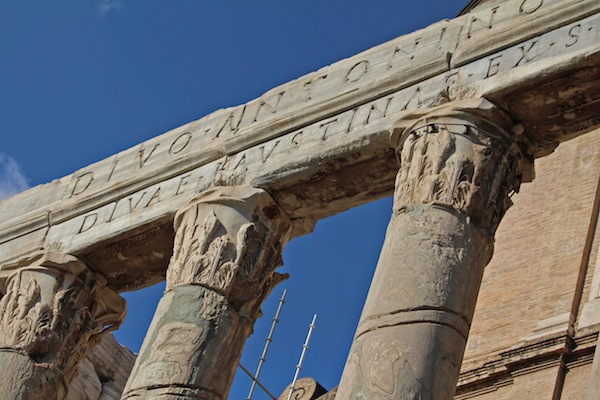
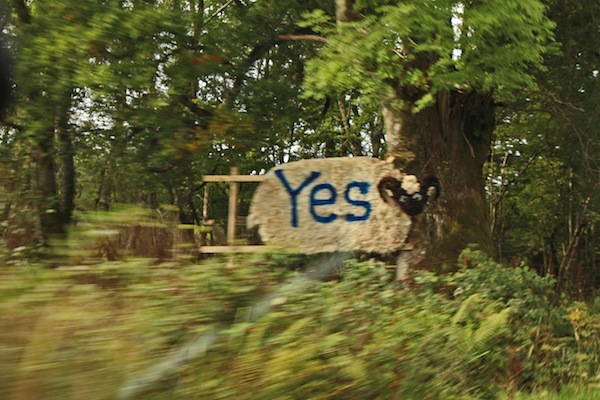
It’s official; Scotland is our favourite place in the UK. From highlands to islands, across moors and lochs, at the Highland Games and sheepdog trials, we’ve had a hoot-mon!
It seems people fight over Scotland a lot. We arrived just weeks before the referendum on independence from the rest of the UK.
The polls seemed pretty evenly split until the day dawned and the No campaign won through. But the ballot boxes had barely been stored away before voices of regret began to be heard.
More than 250 years ago Bonnie Prince Charlie must have had a few regrets as his army became bogged on Culloden moor and was routed by the English – sealing the fate of a nation to this day.
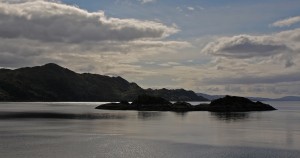
Bonnie Prince Charlie arrived here to start the Scotish revolution. Within nine months he was defeated and on the run
We had no regrets in Scotland. The sun shone almost daily – bringing the bluest skies and gorgeous views from the Highlands and Islands alike.
We sailed over the sea to Skye; hiked up to the Black Cuillin and out to Neist Point lighthouse; met the most majestic sheep we have ever seen and much, much more.
Oban has a couple of stand out landmarks. The first is a folly – the huge Coliseum style building looming over the town and the whisky distillery that gave the town its name and occasionally gives its scent.
In Oban we met an American woman making ready to compete in the Masters International Highland Games the following week in Inverness. We couldn’t resist the trip.
At the risk of sounding dismissive – Highland games revolve around throwing unfeasible long, heavy or awkward objects around.
Sometimes the size, shape and requirements are too much to handle.
It was a Masters tournament, so that means over the age of 40. The oldest competitor was 84!
It was incredible and topped off with a world record simultaneous caber-tossing extravaganza!
Inverness is a lovely city – with the fish-filled River Ness running through it and of course the infamous monster-filled loch close by. It has a handsome castle,
the most fantastic arts centre, where we saw the premiere of the Nick Cave film, 20,000 days on Earth , took lovely river walks,
complete with mid-stream wooded islands stuffed with proper toadstools and the most moving pet cemetery. We were very taken with Inverness!
There are many more photos in the slideshow than we’ve featured in the blog – so please, raise a glass to Scotland and enjoy the beauty of the place with us. If you still haven;t supped enough of the spirit of Scotland, there are even more photos on our Flickr page – so have a peek at those too!
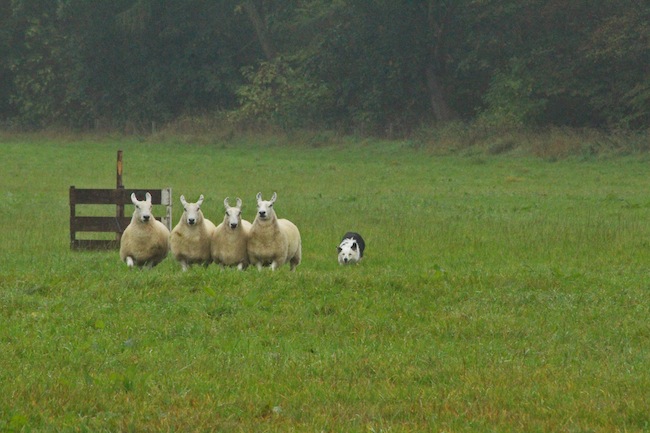
Herding sheep? Easy. You grab one and the rest just follow, well, like sheep, right? Oh, no. It’s complicated, but don’t worry – there are cute puppy pictures as well!
Neil Ross is a champion sheepdog trainer.
A no-nonsense Scot who is one of the last full-time shepherds in his region in Inverness-shire, he also spends years training his sheepdogs. And it shows.
It takes at least two years to train a sheepdog. The first year is spent training to voice commands – lie down, away to me, a few bits of swearing and general chat seemed to be the standard. The second year is training to a specific whistle
Each dog has its own whistles and there are eight commands, so if you have eighteen dogs, as Neil does, that’s a lot of whistles. However, stop is stop and universal for all.
Neil’s skill isn’t limited to handling the dogs. He can fling a mean sheep around too.
And never mind those Aussie shearers with their electric cutters – Neil scalped this one in pretty short order, while maintaining a constant monologue on the evils of mechanical razors!
We were more interested in the smaller fleeces.
Feeding baby lambs is nice and all that, but where are the puppies?
Neil’s yard was good training for us, as the next day we were off to a real sheepdog trial.
Unusually for our Scottish trip, the weather was not being kind to us, but the show trial must go on.
Soon the grey mists lifted and we could see the dogs in action.
There are five main components to the competition:
The lift – where the dog races down the field, coming up behind the sheep and moves them off their standing position…..
The drive – bringing the sheep back up the field to the shepherd and around the standing post…..
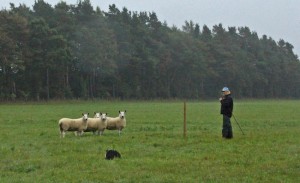
The sheep must be herded down a long field and brought to the shepherd. Some look surprised to have arrived!
Gates – taking the flock through two gates….
The pen – getting the sheep into a pen. Some encouragement from the shepherd with the gate rope or his stick is permitted, but not encouraged…..
Splitting the herd – in some competitions, specific sheep with coloured collars have to be split from the main group, but at this trial it was simply a question of going in two-by-two….
Some were mighty impressive and some were having a bad day.
And some simply got on the wrong side of some pretty grumpy sheep.
But the level of skill amongst them all was undeniable. Dog and trainer in perfect harmony. If you ever get the chance to go to a sheep dog trial – grab it, we promise you’ll enjoy it!
Okay, okay – here are the puppies again!
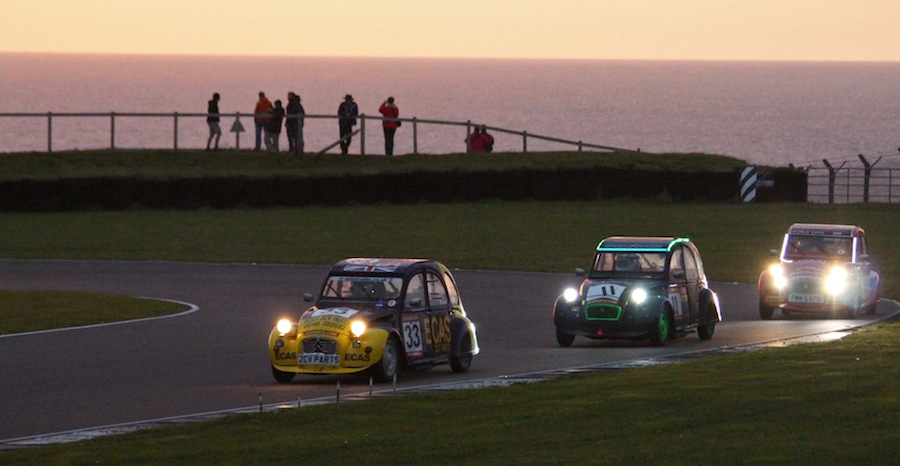
A twenty-four hour 2CV race, the chance to drive the track in Charlie Charleston, oh, and a hurricane for good measure. Yes, it was all as daft as it sounds.
It all started in a lay-by in Leicestershire. That’s pronounced Lester-sheer in case you are not sure – not Lie-cester-shire as it may look. That is just one small example of the curiosity that is the English language and place names, but more on that another day.
So, there we were, bonnet up and Geoff fiddling with a loose hose. Behind us a motor-home pulled up and Graham and Dawn Daniels hopped out to check if we were okay. “We’ve got one of those too” they said – nodding toward Charlie. Offers of coffee and general chat followed and they told us of the meeting of the 2CV GB club at the end of August, including a 24-hour race. They left us with their phone number, address, email, an offer to stay if we passed their way and a promise that if we needed anything while we were in the UK, to give them a call and they would find a 2CV club member to help us, wherever we were.
Well – if they’re all as nice as the Daniels, then we should go to the meeting and it sounds like a laugh anyway, we thought. We joined the club and booked the next day! Fast forward a few weeks and this was us,
roaring(!) around the Anglesey race track in North Wales, with a hundred or so fellow 2CV owners. The owners parade, to which they came in all disguises, was prelude to the real day and night race.
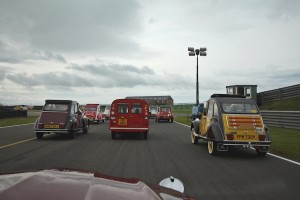
Our car has done more than 30,000km in the last year. The yellow and black one on the right has done less than 300km!
After our turn around the track it was time for the real racers to begin. Not only were traditional 2CVs racing, but also the crazily adapted European cars – complete with BMW motorbike engines almost double the size of a regular 2CV and with all kinds of custom bodywork designs.
In the middle of all of that were, rather incongruously, three Mini Coopers as well – apparently there to make up the numbers and we were all secretly slightly amused to see the lead Mini get side-swiped by a 2CV on the very first corner.
Now, thirty-plus cars with 600cc engines zooming around a race track in Wales might not sound like everyone’s idea of an exciting weekend away, but it was surprisingly dramatic, with suitable doses of comic too.
The sight of the cars almost lifting off as they cleared the hill at the top of the turn, the two-wheeled, downhill cornering, complete with squealing brakes and smoking tyres, made it real racing, regardless of the engine size.
Even the racing marshalls, used to seeing a rather larger cc fly past them at Anglesey looked impressed and admittedly, occasionally amused.
In the pits the sheer endurance of the four-driver teams and their support crew was amazing.
All through the night they powered on, through until the following afternoon.
For some it was harder going than other – Herbie Boy scored 25 pit stops in 24 hours, but by the end, the winning cars in each category had rounded the track more than nine hundred times, driven more than 1200km, and many had worn out two complete sets of tyres each.
All had competed relentlessly and impressively.
Talking of impressive – about that hurricane. North Wales is not known for its balmy summer temperatures and Anglesey racetrack is rather dramatically perched on the western edge of the island, looking out to the Atlantic. As we wrestled to put up the tent, we almost snapped the poles, ripped the nylon and generally feared that our home might not make it through the night. “Is it always this windy?” we asked. “It’s been like this all week. The locals say if the wind stops it’s the end of the world,” a cheery young lady marshall in shorts and a t-shirt beamed at us! It wasn’t until two days later that someone confessed we had been putting up our tent as the tail-end of a hurricane passed over – the locals must have been in heaven!
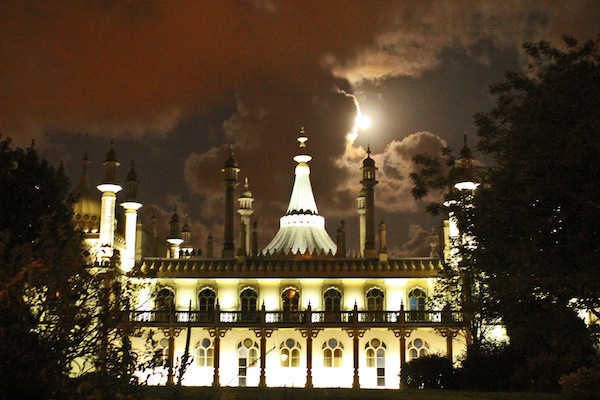
We’ve been criss-crossing England and Wales for the last few weeks – visiting friends and family – so fewer stories to tell than usual. But here’s a few photos from our travels – including a quick trip to Cornwall, a birthday treat in Brighton – where our night-time love affair with the Brighton Pavilion will become apparent (the inside is even better but we weren’t allowed to take photos) and contrasts rather spectacularly with Stonehenge!
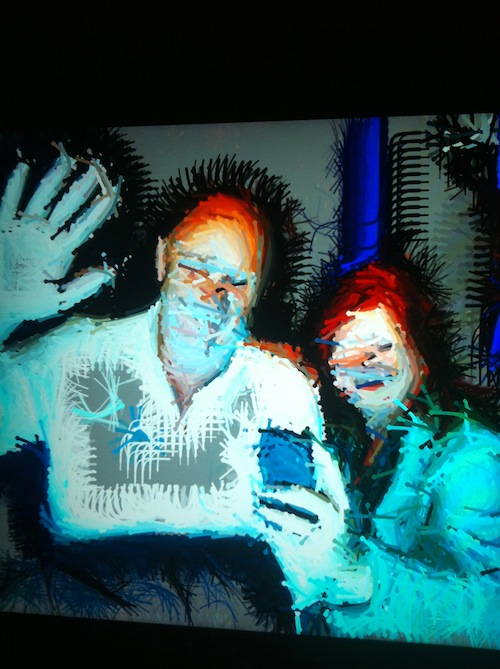
It’s pretty fun when you can re-live your digital youth and peer into the future all in the same day. Complete with a few happy snaps from an iPhone – here’s your chance to do the same.
The Digital Revolution is an exhibition at the Barbican Arts Centre in London, spanning the startlingly short timeframe between some of the first computer creations to today and glimpses of what is still to come. While we might baulk at some of our digital addictions – such as the 183 billion emails sent every day – who could fail to be enthralled by the seemingly limitless possibilities of it all. The first part of the exhibition looks at how it all began – with some memory-jogging moments like the early Apple Macs,
Remember Andy Warhol in 1985 making art with an Amiga 1000 and Debbie Harry, live on air.
And it wasn’t just artists making musicians into art, it was musicians making art into pop, when Dire Straits aired their ground-breaking video in 1985.
That partnership was brought right up to date by Will.i.am and Yuri Suzuki in the Pyramidi – making art and music together, with reconstructed musical instruments that looked like decorations, and an ever-changing face that followed your every movement – the photos don’t do it justice so do check out the website – it was pretty groovy!
There were also a few historical surprises – did you know that the technology used in The Abyss became Photoshop? As the exhibition continues, so does the magnitude of digital development. A fascinating film from Tim Webber about the creation of Gravity tells of how it was more than a year in pre-production rendering before they even brought a single actor into the studio. Indeed, even in the end, the human part was literally a fraction of the actors involved.
Along the corridor and the digital mirror is held up to our faces – and this is how we look :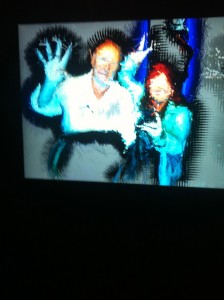
Daniel Rozin’s “Mirror No. 10” which turns the viewer into almost an abstraction was a lot of fun, as was the freakish installation by Rafael Lozano-Hemmer – titles “The Year’s Midnight” . After staring into a video image of yourself for a few seconds, smoke comes pouring from your eyes, regardless of which way you moved your head.
And if that isn’t enough, check out the birds in Chris Milk’s The Treachery of Sanctuary As you watch your shadow raise its arms, the circling birds swoop down and begin devouring you – fingers first – until you move along to the last screen where all childhood dreams come true and you really do get to grow wings and fly away – amazing!
Other birds came alive when you called – on the telephone. The faces of some feathered friends were pasted onto old mobile phones and just one call from an even older style analogue phone was enough to bring them to life. It was pretty dark, so the pictures on their phones are better than the one on ours! It was not all art – some was very sobering reality, such as the dronestagram – set up by journalist James Bridle to show US drone strikes in Afghanistan and Yemen – images that we rarely would see otherwise.
This is his take on technology: “History, like space, is co-produced by us and our technologies: those technologies include satellite mapping, social photo sharing from handheld devices, and fleets of flying death robots. We should engage with them at every level. These are just images of foreign landscapes, still; yet we have got better at immediacy and intimacy online: perhaps we can be better at empathy too.” The exhibition was enlightening, exciting, sobering and fascinating all in one. If you get a chance to see it in London or it comes to your town – don’t miss it.